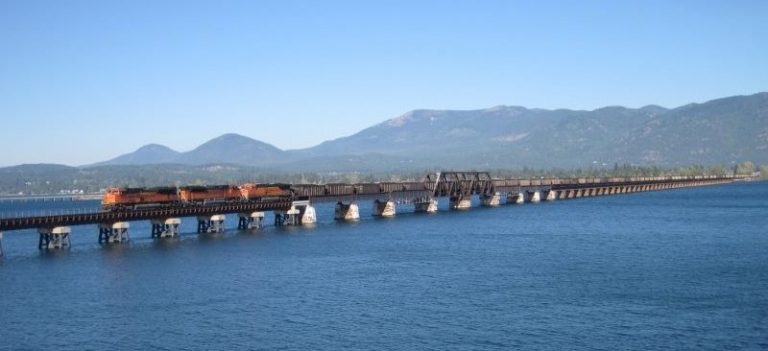Idaho’s Lake Pend Oreille at Risk of Hazardous Material Train Derailment
By: Lake Pend Oreille Waterkeeper

By Sharon Bosley, Communications Associate, Lake Pend Oreille Waterkeeper
Lake Pend Oreille is the fifth deepest lake in the United States and one of the most majestic lakes in the Pacific Northwest. It is located in the Panhandle of Idaho near the town of Sandpoint. Sandpoint is the gateway for an abundance of outdoor recreation—it is also a major railroad hub. In fact, the area is a choke point where several rail lines converge and trains carrying hazardous materials like crude oil and coal must cross over a 4,769-foot bridge that spans Lake Pend Oreille. This bridge represents one of the most severe capacity restraints for the BNSF Railway Company on its northern line from the Great Lakes to the Washington Coast.
To help remedy this choke point, Burlington Northern Santa Fe (BNSF) plans to build a second bridge across Lake Pend Oreille. Thanks to the National Environmental Policy Act (NEPA), the first step for a project like this is for the appropriate federal agencies, in this instance the United States Coast Guard, to assess the environmental effects of their proposed actions prior to making decisions. Those findings were recently released in the form of the draft Environmental Assessment (EA). As Chantilly Higbee, the Lake Pend Oreille Waterkeeper, mentioned in a recent Sandpoint Reader article, Lake Pend Oreille Waterkeeper had hoped the Coast Guard would do a more thorough environmental review of the project by performing an Environmental Impact Statement (EIS). Essentially, EISs function as more holistic, big-picture outlooks, whereas EAs are more narrow in scope. We are in the process of reviewing the Environmental Assessment but have many safety and environmental concerns that we hope they take into account and address.
One of the biggest safety concerns we have is the risk of a train derailment. As much as the rail industry touts their safety record, we still see train derailments happening on a weekly basis. In the last month alone, there have been at least 13 train derailments in the United States and Canada. Recently, a coal train derailed near Bozeman Montana. The train involved was heading west towards Sandpoint. The cause of the accident is still under investigation. However, in light of this past month’s activity, Sandpoint should feel lucky there has not been an incident of a derailment in the region since 2017—that year four different trains derailed. Unfortunately, it seems that it is just a matter of time before Sandpoint’s luck runs out and causes pollution in Lake Pend Oreille.
What is concerning about the Montana coal train derailment is that coal spilled into Rock Creek, a tributary of the East Gallatin River. People often believe that unburnt coal is just a rock and therefore cannot affect water quality. That was the same reasoning used by mining companies in the Silver Valley of Idaho in the late nineteenth century when they deposited tons of lead-laden rocks into their waterways. It may look and seem benign, but adding a foreign element to a waterway can have devastating effects. Coal contains pollutants that can be toxic at low concentrations. Scientific studies have demonstrated that unburned coal can negatively affect water quality and aquatic ecosystem function.
The fear of a hazardous material train derailment is a concern for those who live and work near active railways. It is Lake Pend Oreille Waterkeeper’s job to work to protect the health of our lake, but when it comes to the safety of the trains crossing the lake our hands are tied.
We hope that BNSF sticks to their promise of improved safety and preparedness for disaster clean up. For the sake of our lake and local residents, we need to make sure they keep their promises before we allow them to construct a second bridge that will undoubtedly increase train traffic in the Sandpoint area.
